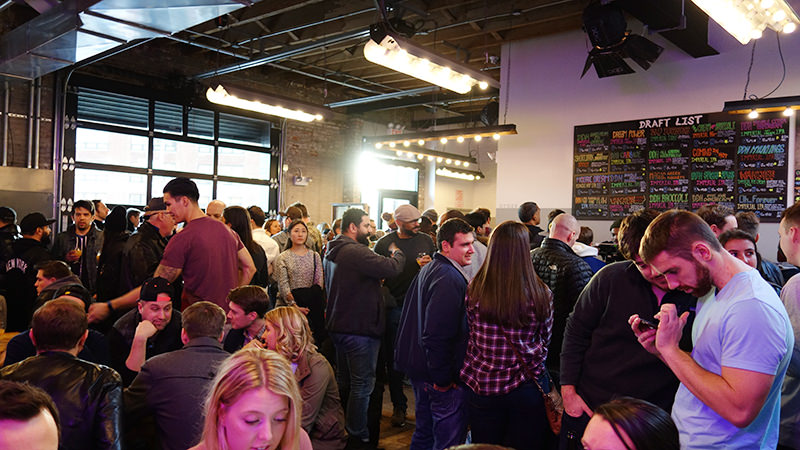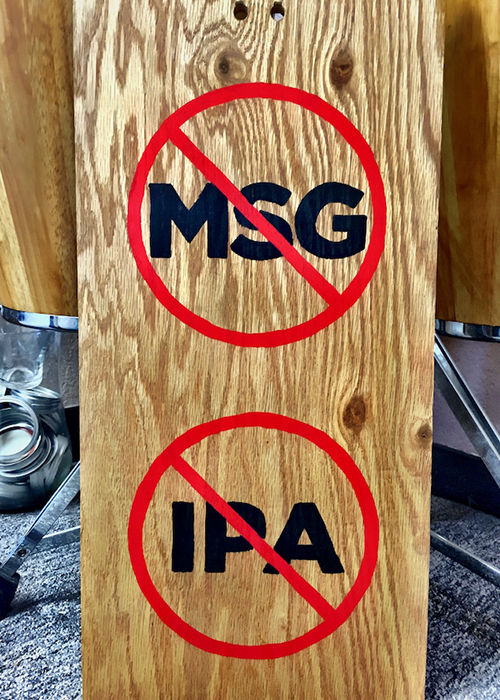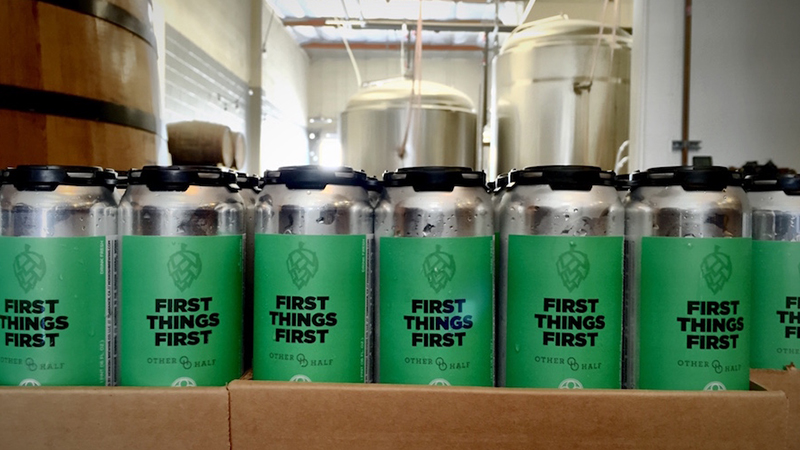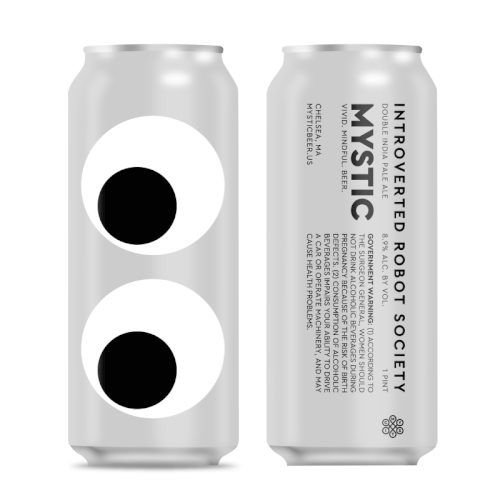“Make fun stuff happen, hang out with cool people.”
That’s how Sam Richardson, co-founder of Brooklyn’s Other Half Brewing, described his business to me in an interview a year ago. We had been talking about the influence of YouTube beer reviewers (Brew Tubers, as I cleverly called them). The conversation eventually turned to review sites like Untappd, and the out-of-proportion praise they heap on IPAs.
Richardson, who helms one of the most famous IPA breweries in the country (and world), admitted that these Untappd all-stars are good for business, but ultimately a mixed bag. “People are super energetic about craft beer and they are looking for mostly positive things to say,” he said. “On the other hand, it’s a distillation of what craft beer is. What [beer has] become for reviewers is double IPAs and adjunct imperial stouts. That’s too bad, because beer is more than that.”
But for many beer drinkers today, beer is IPA. The most popular craft beer style in the country, IPA has birthed its own subculture of beer consumers, whose interests lie in limited-edition, collectible, tradeable cans of hoppy, tropical ales.
It’s an unforeseen success story for breweries like Other Half, whose brewers started out simply wanting to make beer the way they wanted to make it, and share it with the world.
In January 2017, a short while before I spoke with Richardson, RateBeer had released its crowdsourced “Best Brewers in the World” list. Other Half was No. 10 of over 22,500. This year, it’s No. 7. “It’s because we make IPAs,” Richardson said plainly. “IPA is more popular than lambic or … [any] other style. That’s just how it is. Super IPA-focused breweries did extremely well [in the ranking]. A pilsner or helles or altbier is not review bait or trade bait.”
(He’s right. The top brewers listed are Hill Farmstead, Cloudwater, and Trillium, all of which focus on “hazy and juicy” IPAs.)
Is doubling down on these review-baiting beers, arguably at the expense of other styles, a type of selling out? It’s certainly not the same as actually selling stake to Big Beer. And I am in no way condemning Other Half for brewing the beers it likes to make, if that’s indeed the case. But something about marketing beers that feed more accolades and Instagram likes than conversations in a core community feels… corporate.

___
“‘Sellout’ has a negative connotation,” Courtney Daniels, a fellow beer nerd and a chef at Cafe Frida in Manhattan, says. A New York beer lover, Daniels also side-hustles as an “ambassador” for the Bronx Brewery, attending events to show solidarity with the Bronx as a brewery and borough.
Daniels noticed a change in the culture and community at Other Half’s Brooklyn taproom throughout the course of the last year. “When I first started going [to Other Half], it was a little more quaint,” he says. “I kind of knew everybody that was there, the bartenders were a little more personal, because they had less clientele. Now that they’ve become so commercialized, the hospitality is robotic. It’s going down the line — ‘what are you having, what are you having, what are you having’ — there’s no personality.”
I’d had a comparable experience when I visited Other Half’s renovated taproom for the first time in January (although I found the service to be impeccably snappy, given the crowd). What lay before me was unlike anything I’d seen before. People pushed past a bouncer to get in (a bouncer? at a brewery?). The bar was mobbed with a throng of parched patrons at least six bodies deep, stretching from the doorway to the back of the brewhouse. A corner station devoted entirely to can and merch sales was hustling. Behind me, groups sat shoulder-to-shoulder, sloshing milky IPAs over beer garden-style tables, some pairing their liquid gold with grub from “the golden arches” across the street. There wasn’t a seat in the house.
This was Other Half transformed. It was nothing like the familiar, grungy, tiny taproom I’d visited over the course of four years, in which a painfully small space fit a small crowd of bearded, beanie-wearing hipsters.
It was then that the realization struck: Craft beer has changed.
What used to be an “alternative” scene for artists, beer writers, metal heads, and other adventurously thirsty outcasts had become a bustling haven for buzzed bros in button-downs. Other Half was the beer of outcasts, and now it’s the beer of Wall Street.
“You want to go to your favorite taproom and know everyone, not walk in and be bombarded with tourists,” Daniels says. “It’s great for business, of course, but as someone who was there before they became such a big name, it’s a little off-putting. That’s why I don’t go there as much as I used to.”
Losing that sense of “local” tends to drive early supporters away — me included —while at the same time, the brand and brewery grows. “It’s great, don’t get me wrong— it’s great to build your brand — but to lose your personality sucks,” Daniels adds. “That’s capitalism, isn’t it? You gotta grow somehow. So the majority always wins.”
___
Other Half is not the only brewer cashing in on tasty IPAs and the bros who love them. Breweries across the country are doing it, so much so that we’re seeing NEIPAs trickle up from the niche to the national.
In a recent conversation with Justin Kennedy, beer writer and author of the “Scratch and Sniff Guide to Beer,” he rattles off several examples: Monkish Brewing, of Torrance, Cal.; Mystic Brewery, of Chelsea, Mass.; and Trillium Brewing, based in Boston, with a second location in Canton, Mass.
“Monkish originally started off as a Belgian-style brewery in 2012,” Kennedy says. “If you go back and look at the first five years, they don’t mention IPA at all.” In fact, he says, they used to have a sign up in the taproom that read,“No MSG, No IPA.”

Five years ago, in March 2013, the beer menu on Monkish’s website had 17 beers on it. All of them were Belgian-style ales. In April 2014, 27 beers were listed on the menu, all of them “Belgian-style” save for two, a farmhouse ale and a saison (so, Belgian).
Then came a collaboration with Other Half in April 2016: First Things First IPA. It was Monkish’s first IPA can release (on April Fool’s Day, no less). It sold out in an hour.
The brewery published a blog post addressing its change of heart.“We put that [No IPA] sign up as a joke,” the post reads. “We knew we would make IPAs someday.” It claims the brewers’ inability to secure hop contracts was the reason for not initially brewing IPAs.
“It was kind of a bullshit excuse [as to] why they were coming around to it,” Kennedy says, but adds, “It was definitely a business decision, and no one can fault them for that, because they’re the best at what they do. They’re the one West Coast brewery that does that style really, really well.”

Trillium also changed its tune a few years in. “Their original focus was to have a farmhouse brewery, on an actual farm,” Kennedy says. “Their flagship for the first couple of years was a farmhouse-style ale. It wasn’t until 2014 or 2015 that they started making IPAs.”
Today, Trillium’s second location in Canton is dedicated to canned IPAs, along with wild and sour beers. “Right now, IPAs [make up] half their production, but if you go back and check out when they first opened … it’s pretty telling that they were focused on something entirely different at the time,” Kennedy says.
Still, he believes that labels like Trillium and Monkish aren’t sheep-like followers — they have pioneered the IPA category. “These are guys that kind of invented or popularized that style,” he says. “I don’t think you can fault them for wanting to make millions of bucks off of this craze.”
___
Mystic Brewery founder Bryan Greenhagen says he planned to brew IPAs from the start, but the brewery simply couldn’t afford it.
“The original business plan was actually cans, IPAs, the whole gamut,” Greenhagen says. “It’s actually a decent amount of volume [to brew IPAs]. We started on pretty short money — about a third of what most people start with — with a method that’s pretty rare, of taking our tanks to other breweries and doing the brew day there, basically renting someone’s equipment just to make wort, and then hauling it back over to our brewery where we made alcohol. Given those constraints, we weren’t looking for a ton of volume to get started, so anything super hoppy we put on the shelf till later.”
Greenhangen says he and his brewers cut their teeth on traditional styles at their own location, while learning the classics on a professional scale, developing their techniques. “We knew we could always add IPA when we could handle the volume,” he says, “and that we would be better prepared, and perhaps put our own twist on things, once we got to the point where we wanted to start doing them.”
That time came when Mystic inherited a brewhouse from Hill Farmstead. Although the system didn’t magically produce delicious IPAs, Greenhagen says, he felt “blessed” that brewers like Hill Farmstead, Alchemist, and Tree House had paved the way for fruitier, softer IPAs, the kinds he was interested in brewing. “Back when we were getting started, I personally wasn’t a huge fan of the trend toward super bitter, super resiny, super harsh [IPAs],” he says. The NEIPA forefathers “have changed what people appreciate in IPAs,” so that, serendipitously, “when we started expanding, we could do [IPAs] I personally like better.”
After four years without an IPA, Mystic introduced them to the lineup. “About two years ago, that’s when we started consistently making draft [beer], and the popularity boomed when we started going to cans,” Greenhagen says. “Because people can’t trade draft as easily.”
Now, Mystic has regular can releases and is in the process of opening a second location in Malden, Mass., in a renovated candlepin bowling alley. Greenhagen is also embarking on his own side project of artisan-style lagers.
“Now that we have IPAs figured out, and figured out how to run a business, we can go back to square one again with less stress and pressure, and take on a new challenge,” he says.
Since then, the growth has been “exponential,” he says. “We’re starting to get the lines. There was actually a line in a nor’easter, one of the bomb cyclones, this month,” he laughs. He believes it was for Bumbleberry Frappe IPA, a milkshake-style IPA with lactose and fruit.
“Being traditionalist at the beginning, it doesn’t make sense to a lot of people,” he says. “But I just highly respect those styles that have been made for hundreds of years, and as a research scientist, experimenting and trying to make beers with fruit that aren’t, you know, awful, is fun.”
(Before Mystic, Greenhangen worked for a company that did industrial fermentation, called Microbia.)
“I’ve learned not to overthink it, or to restrict what we’re doing … I think more in terms of skills instead of some sort of philosophical thing,” he says.

___
Can a brewery survive without selling IPAs? “Yes, under the right circumstances, and with a very specific, certain kind of business plan which is not this 2000-era, build-your-own-brewery, put-stainless-steel-everywhere model,” says Greenhagen. “I think you have to have something that has way lower cost, [like] in the countryside.”
“I think it’s a financial decision, and I’m not going to fault anyone for wanting to make money,” says Kennedy. “It’s much easier to be on our side of it [as consumers] than on their side of it [as brewers] trying to pay rent.”
We all know IPAs are here to stay. We know the challenges of opening a brewery can seem insurmountable, and that even after opening, staying afloat is a constant worry. IPAs are the hazy, golden ticket. I don’t fault brewers for making them and making a living. Who would?
But any brewer or beer industry member will tell you the reason they got into the scene, other than their livelihood: the community. When beanies turn to button-downs, conversations turn to can releases, and self expression turns to pleasing the masses, is craft beer even craft beer anymore?
